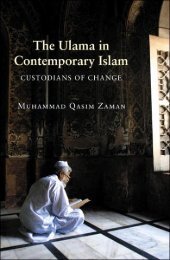The Qur'an in its historical context (pdf - Islam and Christian-Muslim ...
The Qur'an in its historical context (pdf - Islam and Christian-Muslim ...
The Qur'an in its historical context (pdf - Islam and Christian-Muslim ...
You also want an ePaper? Increase the reach of your titles
YUMPU automatically turns print PDFs into web optimized ePapers that Google loves.
SIDNEY GRIFFITH<br />
thematic, they have done so almost <strong>in</strong> a vacuum, without much to say about their<br />
methodological <strong>and</strong> hermeneutical presuppositions. <strong>The</strong>re have been few if any<br />
efforts to set forth well articulated <strong>and</strong> <strong>historical</strong>ly plausible sets of pr<strong>in</strong>ciples or<br />
hypotheses <strong>in</strong> the light of which the stipulated co<strong>in</strong>cidences between Syriac <strong>and</strong><br />
Qur’anic usages or modes of expression might f<strong>in</strong>d their most likely significance.<br />
From the l<strong>in</strong>guistic <strong>and</strong> philological po<strong>in</strong>t of view, already <strong>in</strong> the early years of<br />
the twentieth century scholars work<strong>in</strong>g <strong>in</strong> the west were assum<strong>in</strong>g that there was<br />
a Syriac background for a significant portion of the Qur’an’s Arabic word<strong>in</strong>g. 1<br />
Alphonse M<strong>in</strong>gana, writ<strong>in</strong>g <strong>in</strong> 1927, estimated that 70 percent of the “foreign<br />
<strong>in</strong>fluences on the style <strong>and</strong> term<strong>in</strong>ology” of the Qur’an could be traced to “Syriac<br />
(<strong>in</strong>clud<strong>in</strong>g Aramaic <strong>and</strong> Palest<strong>in</strong>ian Syriac).” 2 Not<strong>in</strong>g M<strong>in</strong>gana’s estimate of the<br />
high <strong>in</strong>cidence of Syriac etymologies for a significant portion of the Qur’an’s<br />
“foreign vocabulary,” Arthur Jeffery then wrote <strong>in</strong> 1938 that “one fact seems certa<strong>in</strong>,<br />
namely that such <strong>Christian</strong>ity as was known among the Arabs <strong>in</strong> pre-<strong>Islam</strong>ic times<br />
was largely of the Syrian type, whether Jacobite or Nestorian.” 3 He noted further<br />
that numerous early <strong>Islam</strong>ic texts mention Muhammad’s contacts with both<br />
Syrian <strong>and</strong> Arabian <strong>Christian</strong>s <strong>and</strong> this observation prompted Jeffery to conclude<br />
that these testimonies, com<strong>in</strong>g from with<strong>in</strong> the early <strong>Islam</strong>ic community, “at<br />
least show that there was an early recognition of the fact that Muhammad was<br />
at one time <strong>in</strong> more or less close contact with <strong>Christian</strong>s associated with the<br />
Syrian Church.” 4<br />
<strong>The</strong> effort to shed further light on the conundrums of the Arabic Qur’an by<br />
reference to Syriac lexicography <strong>and</strong> grammatical usage found <strong>its</strong> most persistent<br />
advocate at the end of the twentieth century <strong>in</strong> the work of the author who<br />
employs the pseudonym Christoph Luxenberg. 5 Alleg<strong>in</strong>g that both traditional<br />
<strong>Muslim</strong> mufassirun <strong>and</strong> modern scholars alike have neglected what he calls the<br />
“Syro-Aramaic” roots of Qur’anic Arabic <strong>in</strong> favor of an overly exclusive reliance<br />
on Bedou<strong>in</strong> Arabic idiom for data to expla<strong>in</strong> the text’s mean<strong>in</strong>gs, Luxenberg’s<br />
method is to exam<strong>in</strong>e selected cruces <strong>in</strong>terpretum <strong>in</strong> the text from what he calls<br />
the “Syro-Aramaic” perspective. He changes the vowels <strong>and</strong> diacritical po<strong>in</strong>ts of<br />
selected lexemes as necessary, to explore the possibility that with the Syriac<br />
dictionary <strong>in</strong> h<strong>and</strong> a more <strong>in</strong>telligible read<strong>in</strong>g of hitherto obscure passages may<br />
be atta<strong>in</strong>ed, often then found to be congruent with earlier, Aramaic grammatical<br />
forms or syntactical usages. In the ensemble, the over-all suggestion is made that<br />
when it is read from Luxenberg’s “Syro-Aramaic” perspective, the Qur’an can be<br />
thought to have once been a very different scripture from the one it has become<br />
<strong>in</strong> the h<strong>and</strong>s of <strong>its</strong> <strong>Muslim</strong> <strong>and</strong> western commentators from early Abbasid times<br />
until now. Indeed Luxenberg’s enterprise seems, under the guise of a philological<br />
quest, to be a modern-day analog of the efforts of some earlier Arabic-speak<strong>in</strong>g,<br />
<strong>Christian</strong> apologists of the early <strong>Islam</strong>ic period to argue that before it was<br />
“corrupted” by early <strong>Muslim</strong>s, <strong>and</strong> Jewish converts to <strong>Islam</strong>, the Qur’an was<br />
actually a book of virtual <strong>Christian</strong> mean<strong>in</strong>g <strong>and</strong> sensibility. 6 While this is certa<strong>in</strong>ly<br />
not Luxenberg’s avowed purpose, the net effect of his philological methods, to the<br />
degree that they would be deemed plausible <strong>in</strong> <strong>in</strong>dividual <strong>in</strong>stances, is certa<strong>in</strong>ly to<br />
110



